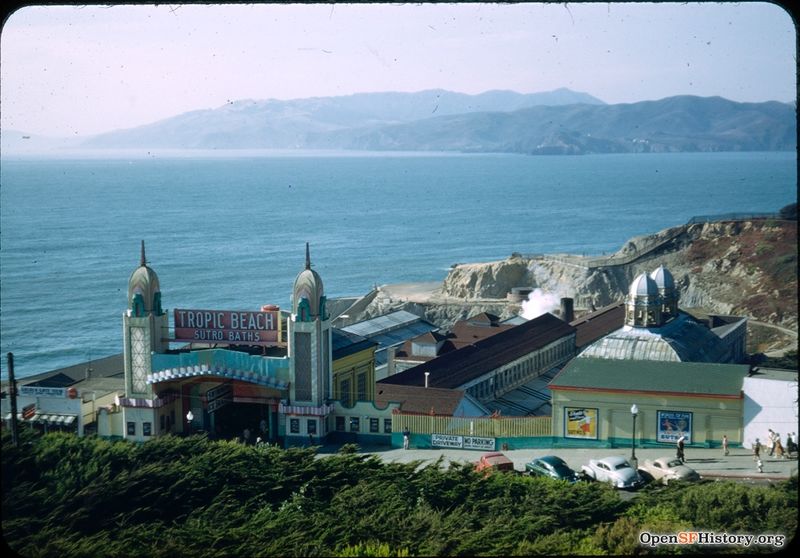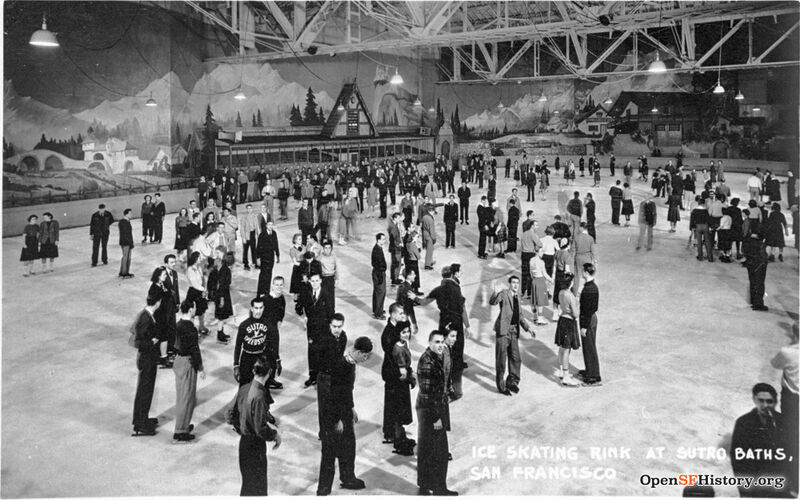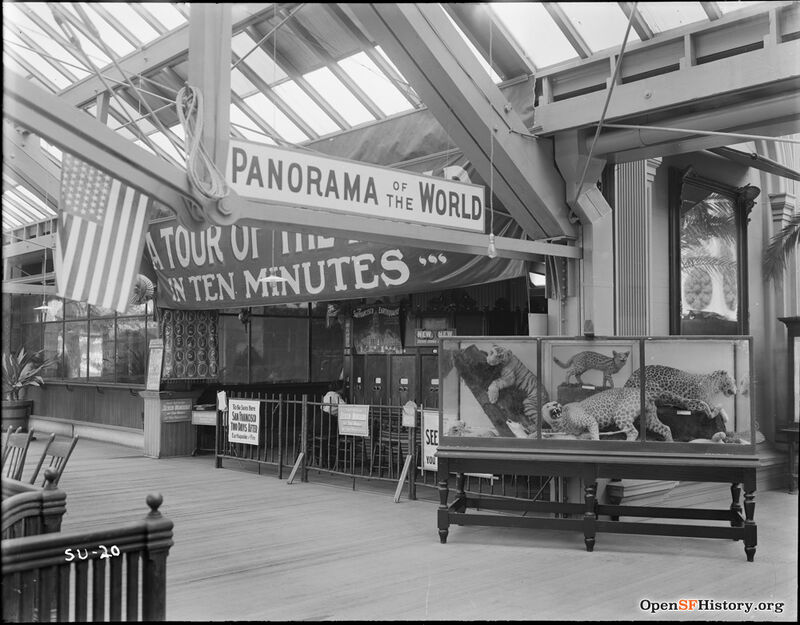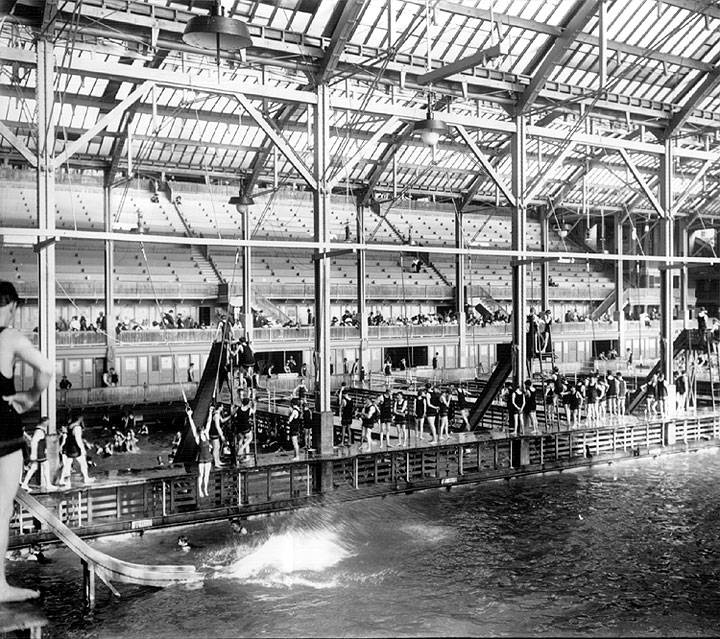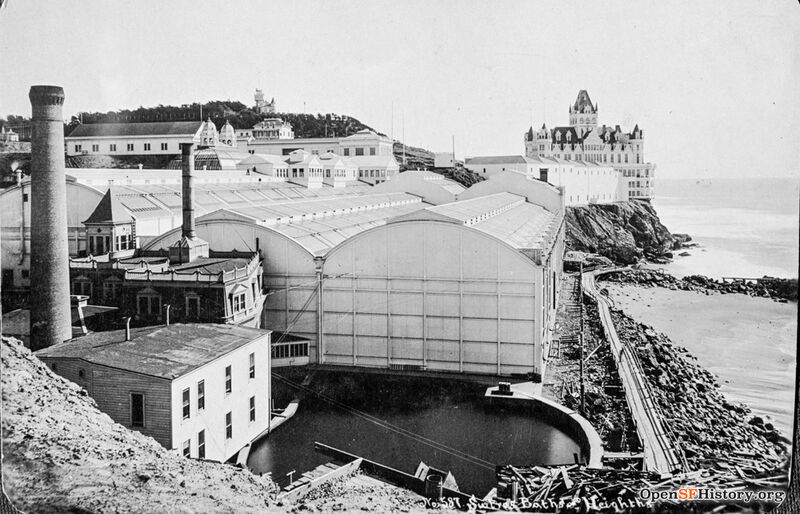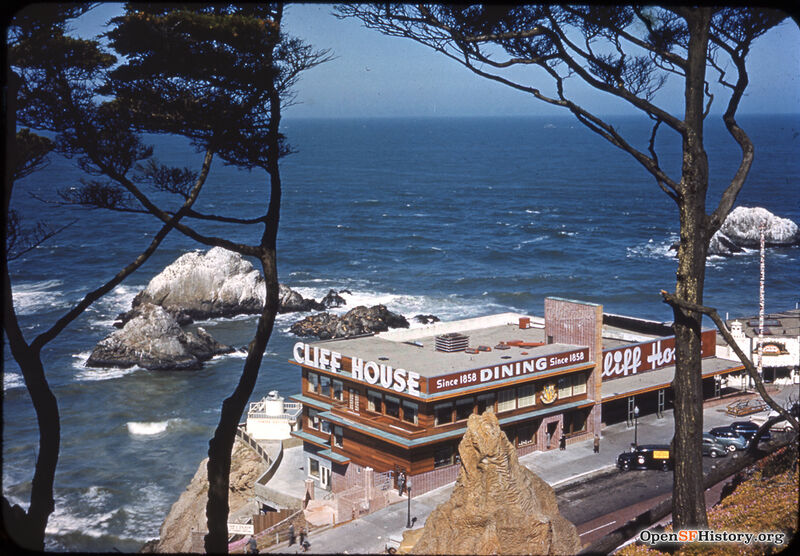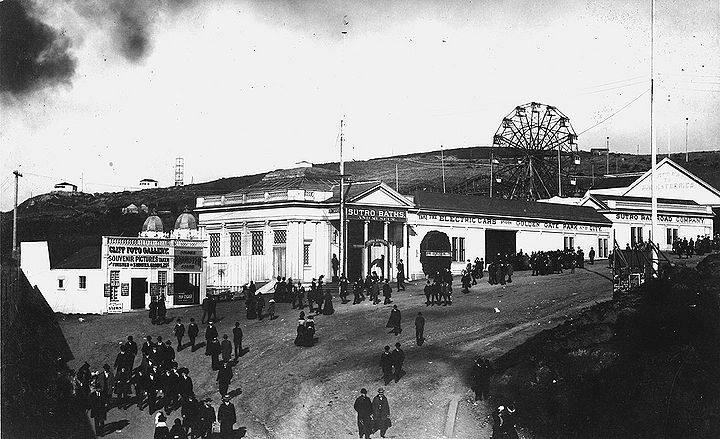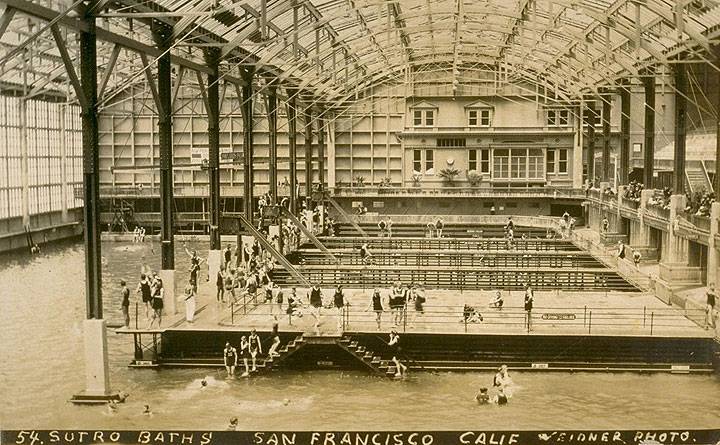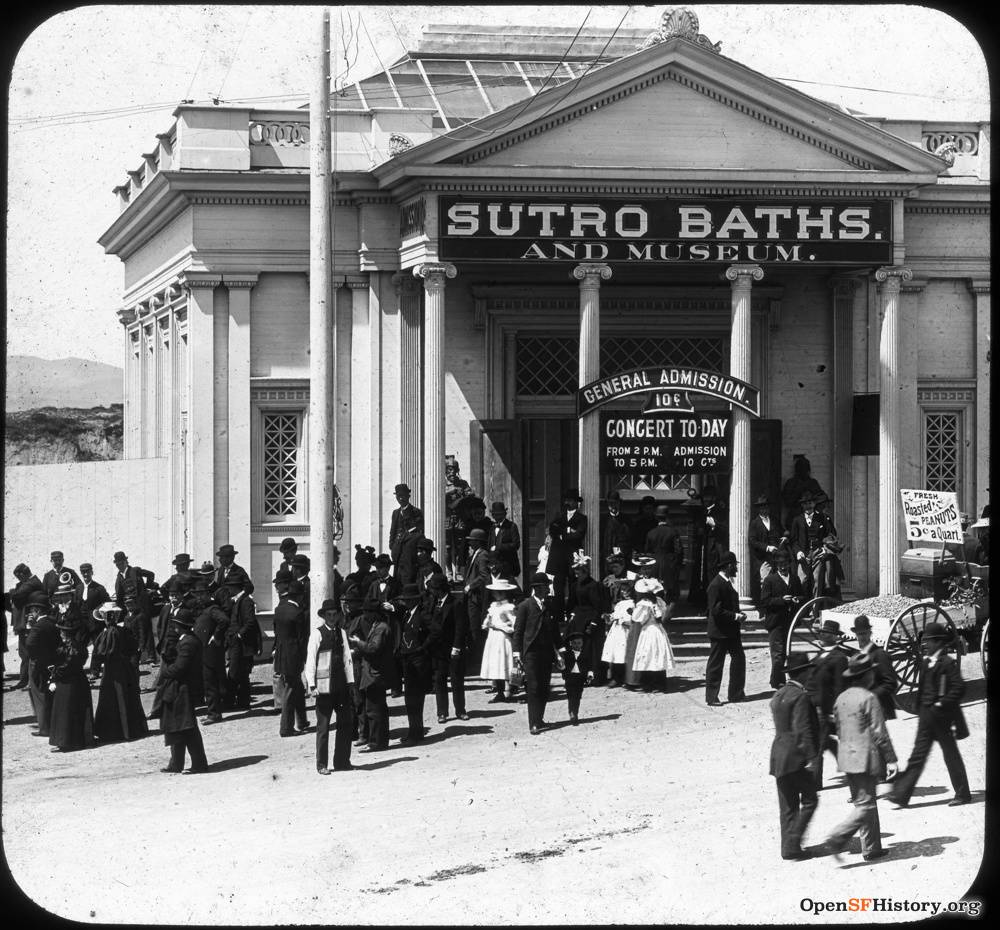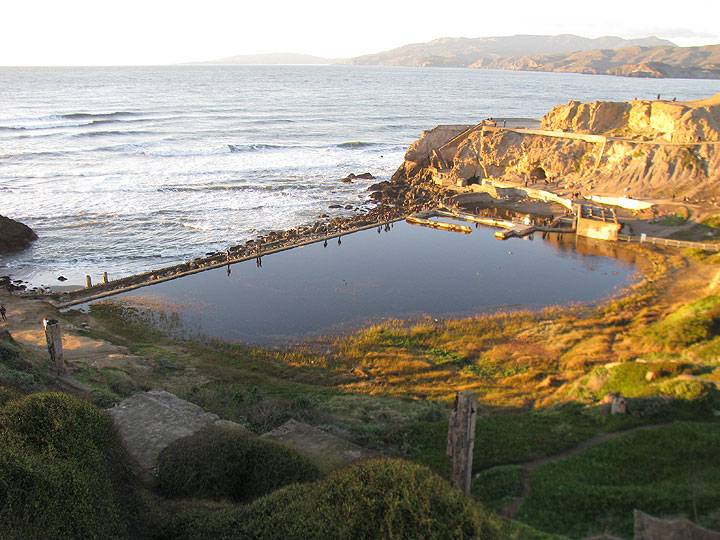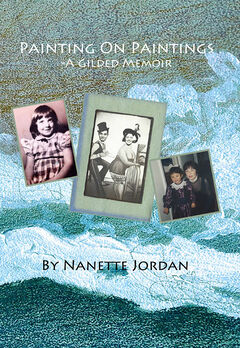Sutro Baths Eerie Ice Rink
I was there . . .
© by Nanette Jordan, 2020, from Painting on Paintings: A Gilded Memoir.
The memories in this story are in an adult’s “voice” looking back at a child’s experience... The adult doing the remembering is me... The child was also me…
Sutro Baths, 1952.
Photo: OpenSFHistory.org wnp010.10136
- San Francisco’s historic Sutro Baths and accompanying museum of curiosities, open to the public in 1869, hang from a cliffside like a glass-paned floating castle. The forward-thinking entrepreneur and former mayor of the city, Adolph Sutro, is the visionary and financier behind the project, developed to provide recreation for San Franciscans and for tourists visiting the city. The many enormous indoor swimming pools are built at sea level, and are fed by the ocean. Sutros boasts the world's largest indoor swimming pool. Numerous exhibits on the floors above the pools house curious antiquities from the travels of the eccentric Mr. Sutro. Relics displayed include extensive collections of historic artifacts, a broad assortment of taxidermy specimens, and a large number of oddities. Materials used in building Sutro’s include 600 tons of iron, 100,000 square feet of glass, 10,000 cubic yards of concrete, and 3,500,000 feet of lumber. During high tides, ocean water flows directly into the indoor pools, recycling two million gallons of freezing seawater an hour. During low tides, a huge turbine water-pump built inside a natural cave at sea level fills tanks at a rate of 6,000 gallons per minute, recycling the water inside in just five hours! The pools, or baths as they are known, are entered by into by swimmers via diving platforms, slides, trampolines, flying rings, toboggans, and swings. Ten thousand people at a time can be accommodated at the Sutro Baths, which rents out woolen bathing suits as well as towels to all visitors. Facilities include six saltwater pools and one freshwater pool with a total water-holding capacity of two million gallons. Sutro's also houses a 2,700-seat amphitheater, meeting rooms with a capacity for 1,100 people, and 517 private dressing rooms. The baths are served by two rail lines built especially for Sutros: the “Ferry And Cliff-House Railroad”, which runs along the western end of San Francisco, and the “Land’s End Railroad,” originating from downtown. Eventually, the baths are closed down and are covered over by an Olympic-sized skating rink. It and the exhibits above remain until Sutro’s burns down in 1966, almost 100 years after it originally opened.
Despite being age ten, I do virtually anything I want to do, unsupervised, but content. It is not uncommon for me to take money from my mother’s purse to finance various pastimes, the favorite of which is ice-skating at Sutro’s, and afterward, walking down the long steep hill to “Playland,” stopping briefly to see the attractions at “The Cliff House” along the way.
Ice skating at Sutro Baths, c. 1940.
Photo: OpenSFHistory.org wnp37.02156
I announce my departure to my mother, calling down the stairs to her art studio in the basement. Her reply: “Be home before dark, please.”
Being raised in San Francisco, I know to always bring a sweater on my outings because it will be cold making my way to ice-skating, and then cold and foggy and drippy all the way home.
Mark Twain is purported to have said, “The coldest winter I ever spent was the summer I spent in San Francisco.” It doesn’t matter that he did not actually say this because San Franciscans know it’s true.
Ice-skating at Sutro’s requires two streetcars and a bus to the end of the line at Ocean Beach, a beach that is never fun, and is never visited by our family or, really, anyone who wants to be safe and warm. Over-large signs are strategically placed along the dunes that read, “Dangerous Undertow.” Since the weather is mostly overcast, touching the tippy tops of one’s tippy toes into the ocean foam will result in going from numb to frozen within minutes.
From the end of the bus line I walk straight uphill six blocks worth. Sutro’s massive castle-like glass structure sits perched atop a cliff with the levels below hanging down like a mosaic glass veil of windows against a wall of rocks. The ocean down below is an angry one, spitting and hissing next to the cliffs, reminding me that there is a darkness about Sutro’s that I feel viscerally.
The gloom begins the moment one enters Sutro’s through one of four overly heavy brass and glass doors, which are located at the street level. It’s as though the doors are saying, “Are you sure you want to come in?” I never am.
From here, the huge otherworldly glass-paned castle drops down many floors to the skating rink on the bottom-most level. It is odd that floor number-one is actually down one floor from street level, and each subsequent lower floor has a higher floor number instead of the other way around.
Just inside the entrance doors, a wickedly small landing gives little warning of the devilishly steep drop of stairway which plummets like a carnival roller coaster. Worse, the entire stairway down is lined with mirrored walls that repeat one’s face in dizzying multiples. Yes, it’s appropriate that there are railings one must hold onto for dear life, but, add to that, that the stairs and walls themselves are painted a glossy Chinese red, and you have a treacherous welcome into Sutro’s world. Someone actually designed this sinister entry to the even more macabre exhibits below, which can only be visited having descended the stairs without incident.
Imagine also, that Sutro’s always appears to have nobody visiting it except me.
There is a perpetually sad sack elevator man who, for years, stands by in wait for a passenger, any passenger…all day. He wears a tired uniform and what must have been, at one time, white gloves.
The odd glassed-in building has a distinctive smell, a smell like old newspapers without purpose forgotten in a moist attic.
Upon conquering the treacherous stairs, there stands, at the bottom, a glass box the size of a small room. And this glassed-in room is positioned within two feet blocking the bottom most stair for what reason I know not. Nevertheless, inside that glass is a wax life-sized, nearly naked Japanese fellow, one ear melted.
A small brass plaque reads, “Ito,” as well as a brief explanation as to why this wax man is important enough to be the welcoming committee. The sign reads that all hairs on the figure are Ito’s own. Did he pluck these out with the intention of saving them should he happen to create a wax likeness of himself? Ito is naked but for a tiny paper-thin hanky that covers his privates. Each visit I make a point of peeking around from the far side of the glass case. It is the only time, at that age, that I have an opportunity to catch a glimpse of what mystery has to be hidden under a hanky in the first place. I am aware of the idea of privates, though I am not aware of why privates are private since I’m told everyone has them.
Next to the door of the “down” elevator stretches a long dark hallway with more than a few burnt-out overhead industrial light bulbs.
Occasional narrow cracks between the thick wood floor planks are worn clear through, offering glimpses of light peeking up from below. I am careful not to walk near these for fear of falling through. Light-filled windows are nowhere to be seen despite the 100,000 perpetually fogged-over glass panes that are the star feature of Sutro’s structure.
The first exhibit one encounters beyond the wax Ito, is a dusty display, inside which stand two well-dressed, albeit three-foot-tall, Victorian-era figures, also a life-sized pony. All three of these I wholeheartedly believe had been alive at one time before they were stuffed. The two little people are either “grown-ups” that look like children, or children that look like “grown-ups.” A sign reads, “Mr. and Mrs. Tom Thumb.”
As I stand looking at the couple, my mind wanders. There is no clue that explains that they may have married each other for no other reason than that they were well-matched in size.
There is a yellowed newspaper page framed on the back wall of the exhibit with the headline, “The Tom Thumb Welcome Parade.” Other than the fact that this couple is small in stature, there is nothing else of interest about the Thumb display, and I wonder what it is that merits the couple earning a welcome parade or even constructing a display for them. Their clothes are cute, but so are doll clothes. I stand waiting to see if anything else captures me but conclude that this exhibit isn’t even as interesting as two marmosets in a zoo cage.
Sutro Baths interior, c. 1910.
Photo: OpenSFHistory.org wnp71.0432
Interior of the Sutro Baths.
Photo: Private Collection, San Francisco, CA
After The Thumbs, I continue down the dark hallway to arrive at a mystifyingly creepy wall-to-wall stage set of a dinner party behind glass of Jesus And The Last Supper. Even though I am Jewish, I have a rudimentary understanding that we killed Jesus, or at least, that’s what my friends at school tell me. Once a nickel is deposited, the frozen life-sized members of the dinner party continuously nod “yes” while the Jesus fellow in the middle is doing all of the talking. He’s identified as God’s son who, I presume, is an only child. It has never occurred to me that God, if there is one, has children. Either way, I’m okay that God’s son has His own concession at Sutro’s.
Jesus tells His guests that they should drink His blood and eat bread, the main ingredient of which is Him. He continues that, soon, He is going home to His Father, who I surmise is living in a one-bedroom apartment much like those in downtown San Francisco.
I dislike this exhibit, not only because of the food served, but also because Jesus is leaving the dinner party early. How rude.
Just outside this glass-walled Last Supper, is a long low red velvet ledge. It makes no sense as a bench as it’s too narrow to sit on even for a child. Also, it’s only inches from the floor. On one occasion, I come upon a mother on her knees facing this Last Supper. She’s kneeling and her hands are folded. A boy stands nearby her. He says he has to pee. The mom is crying. She turns her head away from the exhibit and tells the boy to “shut up.” Whatever made her cry is more important to her than her kid peeing his pants. She’ll be sorry.
By the next dark hallway, I’m in a child’s version of depressed, and I’m more than ready to go ice-skating, that is if I don’t change my mind, buy a Hershey Bar, and just go home instead.
Ahead is the worst display of all with its wood sign above that reads: “ALCATRAZ,” a prison balanced on the top of tiny island in the middle of the San Francisco Bay. Criminals can’t survive escape because of the icy waters. The glassed in exhibit has some sand scattered about on the floor with a few broken seashells….also a sign fallen over that warns: “Danger…Undertow.”
Also behind the Alcatraz glass are poorly made guns formed out of bars of soap with black shoe polish rubbed on. There are knives carved out of toothbrushes with the bristles left on, also three feet of twisted rope out of “real human hair.” This strikes me as unusable as an aid to escape because it is so short. And besides, prison guards would certainly notice prisoners going bald as a group.
A few dirty yellow bed sheets are tied together to hang out a window. Firstly, windows in prison? Also, who would touch these icky pee sheets, let alone slide their whole body down them?
Frankly, with all these knives and sheets and soap and hair, even I could do a better job. However, if it were me, I’d have just believed the undertow sign and stayed safe and warm in my cell. No, Alcatraz is a just plain bad idea all around. Why should criminals have a panoramic view of San Francisco?
Sutro Baths exterior, c. 1896. Second Cliff House is in the background.
Photo: OpenSFHistory.org wnp37.01125
The exhibit that I decide for sure, is the last one before skating is a miniature “Playland" made of toothpicks. A penny makes the toothpick roller-coaster move, but some of the cars have fallen off. The Ferris Wheel lists badly to one side as it turns, and the Tilt-A-Whirl is off its track, meaning any passenger on it would likely be flung up into the air.
Little lit-up gaming booths under the roller-coaster have tiny toy people from a train set winning even tinier stuffed animals. In real life, I know better than to waste coinage throwing them onto pink glass dishes to try to win a sawdust-filled bear.
Now, having withstood as much of the “Ito Museum” as I can stand, it is time to head to the lowest floor and rent skates, which inevitably seem to be mismatched even though the sizes stamped on the outside of each heel are the same. One is always too loose, the other, too big. Also, the blades aren’t sharp and don’t glide well on ice.
Overly loud organ music echoes throughout the virtually empty Olympic-sized ice rink. One can never identify who is playing the organ, let alone where it is. Everyone knows that the rink covers over an enormous ocean-fed complex of icy swimming pools. One skates lightly so as not to fall through spots of ice that may be thin.
Two elderly men skaters wear wool skating jumpsuits zipped up the front. They stiffly attempt modest tricks from times past. A few older ladies with red lipstick, tight curls, and short pleated skirts try to appear young, but one can see blue veins through their beige tights.
A loudspeaker instructs this smattering of skaters to go around in one direction. When the music stops, skaters turn around and go in the other direction. In spite of the rink’s massive size and being almost empty as well, the two old men skaters crash hard into each other. One now has a bloody nose. The other has a slice through the leg of his wool skating jumpsuit. The dripping blood is fire engine red and quickly freezes into the ice rink. I don’t want to skate near the blood. In fact, now I don’t want to skate at all. I leave.
Back at street level, a tour bus is stopped curbside with engine running, yet no tourists embark or disembark. Fumes hurt my eyes. I cover my face with my sweater and run half a block down to the famous Cliff House Restaurant. On a wall outside is a glass case with old photos of past Cliff Houses, all of which had burnt down. I believe that past Cliff Houses having burnt down is the reason the restaurant is perpetually empty.
Third Cliff House, c. 1950.
Photo: OpenSFHistory.org wnp25.1852
Behind this Cliff House, is a viewing platform, a row of human-sized upright binoculars pointing outward to the ocean. I hate them because they look like a line-up of robots with big mean metal faces. Coins inserted promise views of seals sunning themselves on “Seal Rock” in the foggy distance. Instead, the seals look like sleepy, shivering garden slugs piled one on top of another, the larger ones periodically biting the smaller until your nickel runs out.
An arrow points toward a room called “Camera Obscura” right off the viewing platform. The room offers a break from the icy sea-spray stinging one’s face by an unfriendly wind that whips helter-skelter. The floor inside has a big glass bubble in the middle intended to magnify whatever may be swimming by in the ocean sloshing around below, except that the glass is dirty. All that can be seen are frozen brown blobs of something floating by, probably seal BM.
Underneath the Cliff House is “The Musee Mecanique.” It’s a long, icy outdoor hall with tall glass transom-walls intended to protect people from cold sea-spray. It doesn’t. Even the menagerie of viewing machines are wet, but still, they are so enticing that one doesn’t care if one’s sweater and hair drip. The machine that greets visitors first is a glass box with a life-like fortune teller inside…or just his head with its eerie lit-up green eyes. Your fortune “coin” rolls out via a chute. It always says “Try Again,” which even I understand.
Further inside one can peer into standing metal equipage to view short movies. One, touted as “The First Moving Picture,” is a man doing nothing but riding a horse for five seconds. Multiple machines promise “Painted Ladies,” snippets of girls in slips, garters, and stockings making “kissy faces.” These “Painted Ladies,” I feel strongly, should finish getting dressed before starring in these Chaplinesque film clips. Laurel and Hardy poke each other in the eye repeatedly. Charlie Chaplin boils his shoe for lunch. And Harold Lloyd hangs from a hand on an enormous clock as he dangles high above a busy downtown city street, old cars moving below like tiny matchbox toys.
But now, stepping out of the cold, under the very bowels of the Cliff House, is, I believe, an undiscovered exhibit of infinite worth, one of which only I am privy.
An over-dark cave-like room requires moments for eyes to adjust to the very dim light. Once that happens, what is revealed is an enormous dollhouse as big and as enchanting as many dollhouses put together…a doll mansion…no….a doll palace!!!!!
The narrow walkway all the way around the perimeter of the dollhouse enables peering into each and every room. The “Music Conservatory” has tiny sheet music and numerous minuscule musical instruments. A miniature flocked kitten plays with a ball of string near a piano’s leg. A teensy wood violin sits neatly inside a fitted red velvet and leather case. The well-appointed kitchen is equipped with everything one needs for cooking in an era long past. On a center cutting board cakes sit, some with unfinished decor. Baked bread loaves fresh from the oven are ready for slicing. Pies cool on open window ledges. But the best room by far in the over-sized dollhouse is, without a doubt, the children’s playroom replete with wooden pull-toys and “ABC” blocks, an array of miniature Victorian bisque dolls that I covet most highly, and a painted merry-go-round horse fit for “riding.” Even better than the toys themselves is a tiny dollhouse on a table inside the children’s playroom that is just like the “mothership” dollhouse, and inside that an even tinier matching dollhouse!
The author continues on her way, next stop Playland at the Beach! Continue reading.
Sutro Baths, 1921.
Photo: Jesse Brown Cook collection, online archive of California Weidner, photo. I0049475A
Crowds at the entry to Sutro Baths, 1896.
Photo: OpenSFHistory.org wnp13.291
Sutro Ruins, 2013
Photo: Chris Carlsson
Originally published in Painting on Paintings: A Gilded Memoir,2022. Excerpted with Nanette Jordan's permission.

